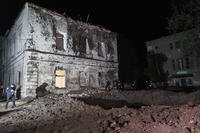My buddy saw the response to my previous post about the M3 Carl Gustaf and wanted to elaborate and clarify a few things for our readers. Below you will see the details that he shared with me on the tactical employment of the Goose, and some of the training considerations. I hope this proves useful for those of you who are fixing to take this recoiless rifle to Afghanistan in the coming months.
Configuration of an Anti-Tank Team:
The gunner carries the gun (CG) and at the MOST an m4 is what we found to be good, but we eventually went with the gunner carrying a nine (M9). The goose can be a chore enough to lug around, and make sure its not dinging on anything (being that the sight mount is pretty sensitive). I must say a two man goose team was essential during rough firefights and made all the difference sometimes where a Javeline would have made none.
As far as being too heavy to hump on a patrol, it's along the lines of a M240, but easier considering you can have it slung over your shoulder. The debate over having a MG team or a CG team is one to be had though when in tight spots for troops on ground. I would say though, having the advantage of putting an HE round into a house around 1000 meters away and putting this fight to an end quickly is one to be thought about.
Combat Load:
As for the normal combat load, we carried one TP (for the doors), 1 Thermo-Baric, two HEDP and a Smoke. The goose had its own case for rounds which made it easy, and the rounds weren't exactly heavy.
The only down side of the goose would be the high range of arming distance on some of the rounds. If I was inside of 100 meters on some targets, I wouldn't (and most didn't) expect to go off besides the fachette. Also, the back blast area is rather large, and you must take all of that into acount. Looking at pictures that you have up [on the previous article] and others that I have seen of people firing the goose is completely wrong, because you need someone to stablize the gunner, watch his back blast, and also watch his impact, much like any AG on a crew served weapon, which I believe the goose falls under.
Back to the rounds being carried. My gunner carried no rounds and especially none in chamber. This was because the safety on the goose is rather touchy, and will switch at the slightest movement. An AD of a goose round would be horrible, because there may be no lives lost, but it is extremely loud. A two man team is more than enough, since your AG (the team leader) carries the goose ruck and rounds and an m4, while the gunner carries the goose and at MOST an m4. (But I would recommend a pistol.) After the intial round, if you need to fire another, your AG needs to ready the next round (dial it in if the round calls for it), and your gunner needs to make sure the tube is clear and he's dialed in for whichever round you are loading up. Sometimes the shells will stick and the gunner needs to be working on clearing that out and getting ready for the next round, so carrying anything besides a pistol is extra work.
Training:
The problems I started seeing in [my unit] were that I was seriously the only one in [my unit] that knew this weapon inside and out and knew what we could and could not do with it. We would get into an Op-order and I would have people saying the the back blast was only 25 meters and 10 degrees off of each side, which simply isn't true, and that is a good way to get people hurt. I also had missions come up in which we were told we were going to fire the goose at a target building within 50 to 75 meters, which wasn't going to work out because the round wouldn't arm. So, being a TEAM LEADER, I constantly found myself jumping up in these Op-Orders, correcting the wrongs and then sometimes being looked at like I was crazy. But in reality, I was the only person (pretty much) in the whole company who knew what the f**k they were talking about when it came to the goose.
As I look at the pictures you posted, the casual approach to this weapon amazes me. Don't know if its the lack of training or experience or just the laziness in the big Army, but it's something that needs to change. When used incorrectly and taken for granted it will not be pretty. The gunner must be held steady, his back blast must be watched and his impact must be watched as well. The communication between gunner and AG is more key than that between the M240 gunner and AG, because the goose has 4 different settings for different rounds and these must be dialed in perfectly, otherwise you could end up shooting a round into the dirt 50 meters in front of you. At the range that isn't a huge deal, but in combat, a mis-dialed goose round going into your buddy's house isn't ideal. I've watched several youtube videos on the goose and its seems to me that a lot of these people are not trained to where they need to be on this weapon or just don't care which is tragic. You must know this also Murph coming from a Weapons Squad.
There aren't two or three ways to run a machine gun team, or fire a .50 cal, there is ONE way and ONE way only, and that is the correct way.
I really believe that the military should have a hard school for heavy weapons and weapon squad tactics and the role that they play in combat, ESPECIALLY in Afghanistan. An ever evolving battlefield it may be, but some of the basics stay the same, and a solid, knowledgeable Weapons Squad behind any platoon is the key factor for victory.
Blast Over Pressure (BOP):
When it came to the BOP effect, I have fired over 25 rounds in one day at a range without serious injury, but I will tell you something; I slept like a baby that night, LOL. I got a little woozy and felt it, but my lungs didn't collapse, LOL. I've had these ranges on several occasions, and I also did a two month train up with the Swedes who manufacture the goose, which was probably one of the best training events I've been through. Knowing exactly what every round does from start to finish and just learning different tactics of this weapon was invaluable. Not to toot my own horn, but I would say hands down I am an expert on this weapon and way ahead of most in the military.
The BOP chart its really mixed up, and I'm sure I have the actual chart somewhere, but it all depends on what round you shoot and from what position, and your AG is affected by it too. I would say in training it's not a HUGE deal, but in combat, you don't want to BOP your guys out and have them fighting the next day.
Kit Up! contributor Jack Murphy is a former Ranger, Special Forces Soldier and is the author of the military thriller Reflexive Fire.










